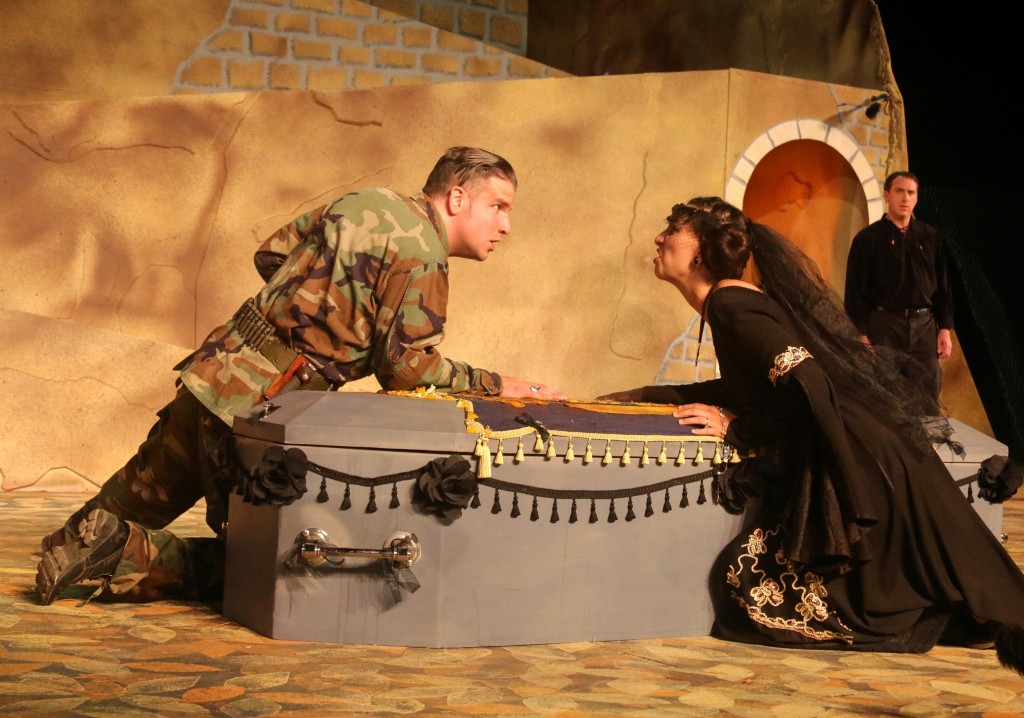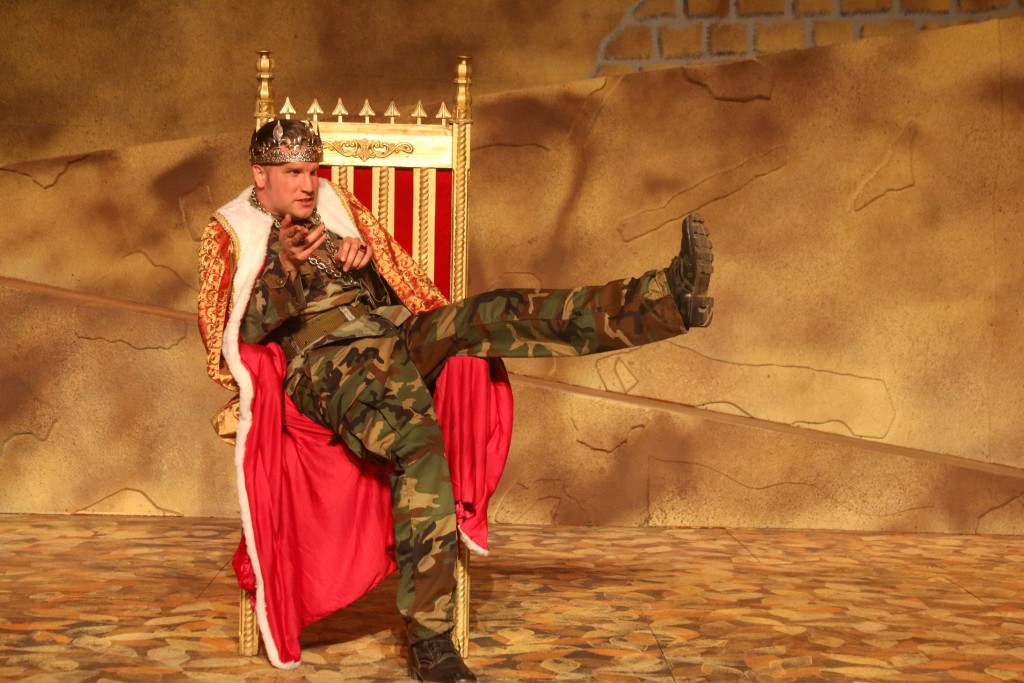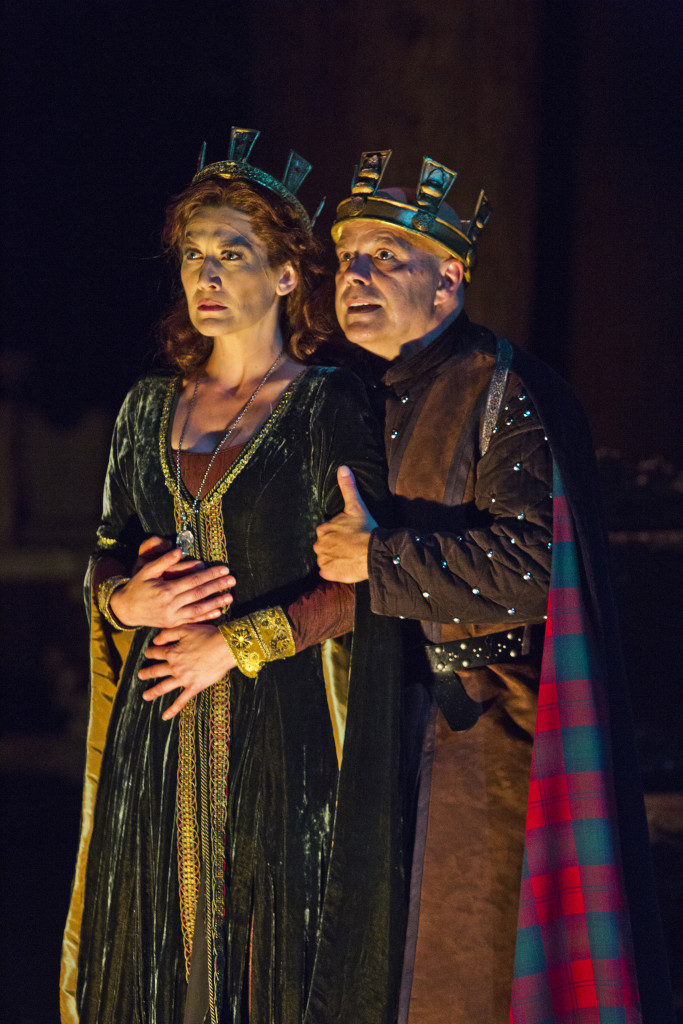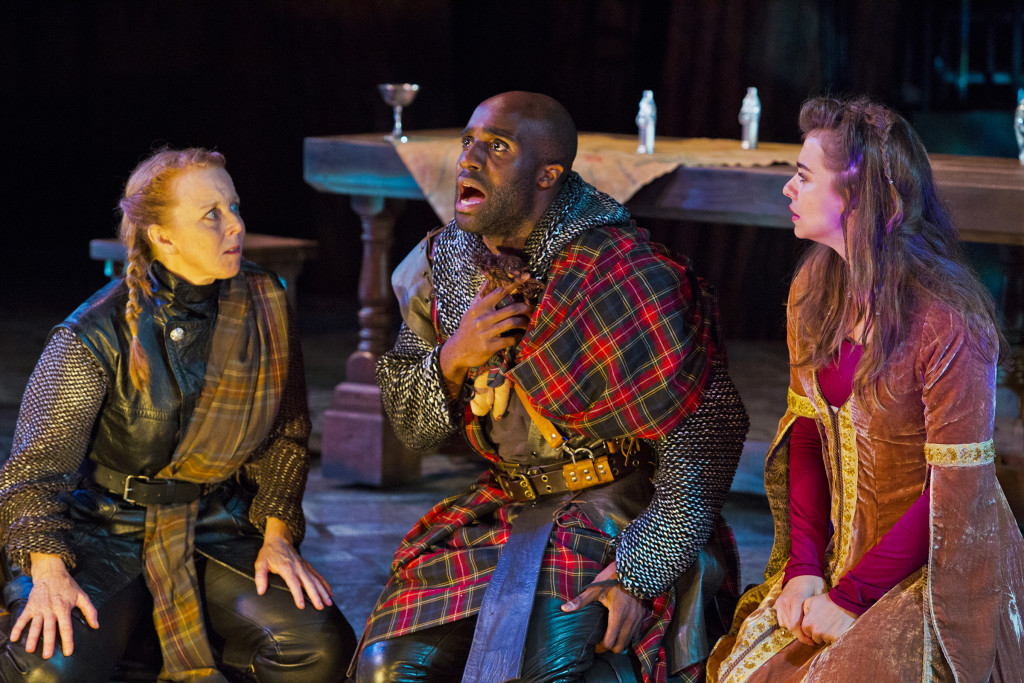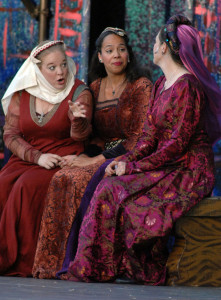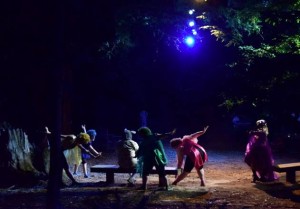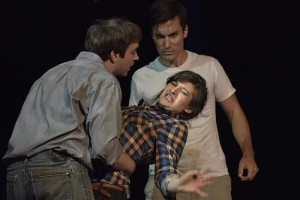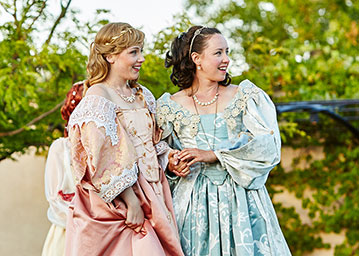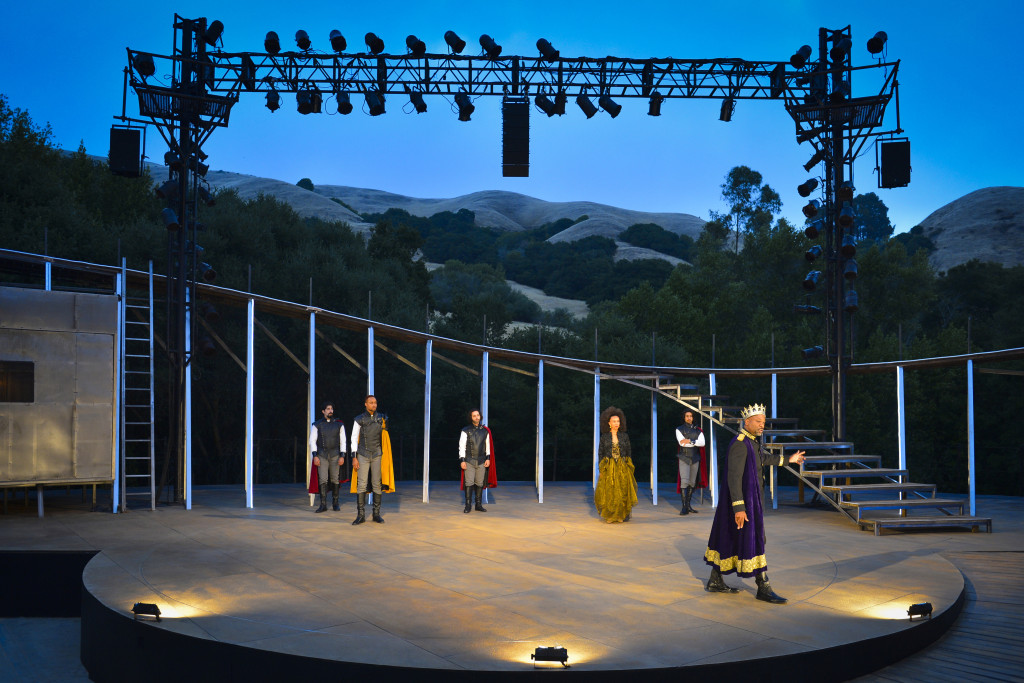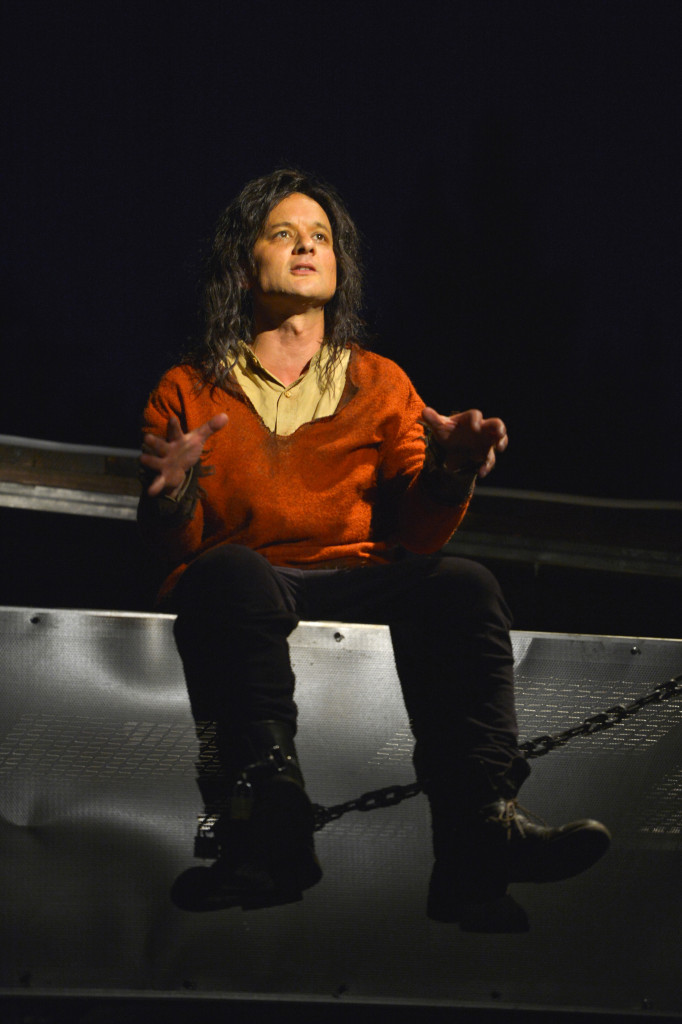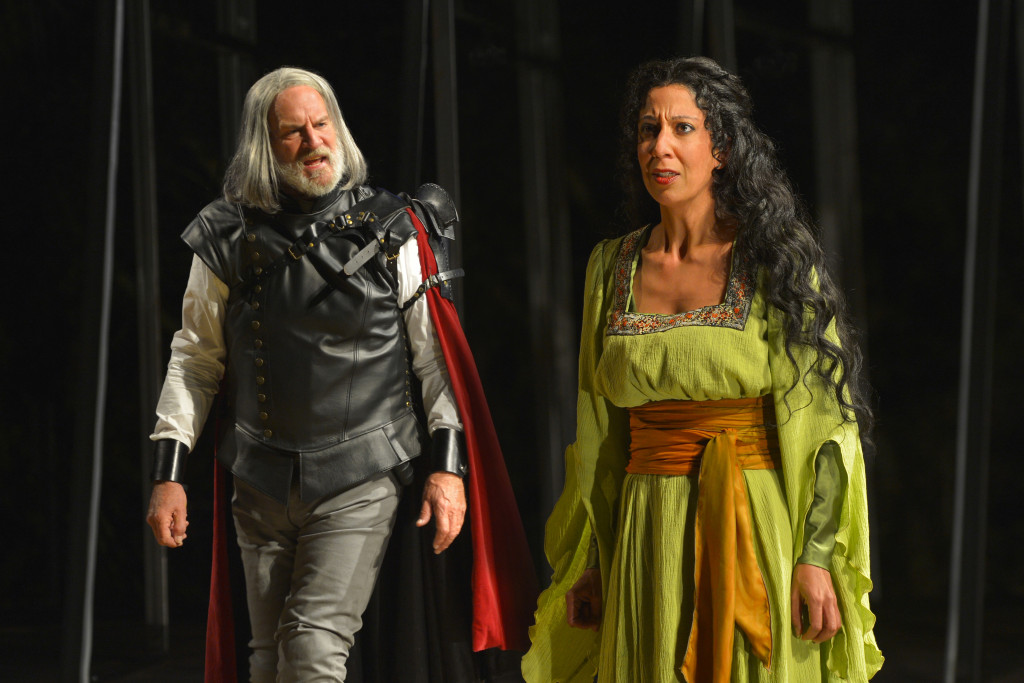Best Xmas Present: Book, Presenting Shakespeare
January 3, 2016 § Leave a Comment
I received a lot of wonderful gifts for Christmas this year, but my son and his fiancé found the sweet spot for my bibliophilia with what is probably my absolute favorite present – a copy of Mirko Ilić and Steven Heller’s wonderful new collection of posters from productions around the world called Presenting Shakespeare.

the cover design
The book’s blurb says, “just as centuries of theatrical artists have reimagined [Shakespeare’s] works through the lens of their own time and culture, so too have illustrators and designers been inspired to create posters that reinvent Shakespeare’s well-known themes for each new generation of theatergoers.” The Folio-sized volume collects over 1100 posters, representing productions from 50 or more countries.
As you would expect from designers of the caliber of the authors (if you don’t know about them you should make it a point to do so soon!) the book is itself magnificently designed. The posters are grouped by title and by visual themes. They cover a span of 250 years, and are a lesson in the development of the graphic arts aside from their interest to Shakespeareans. With several visually related posters reproduced on most pages, it is easy to spend a half hour or so just contemplating three or four pages.
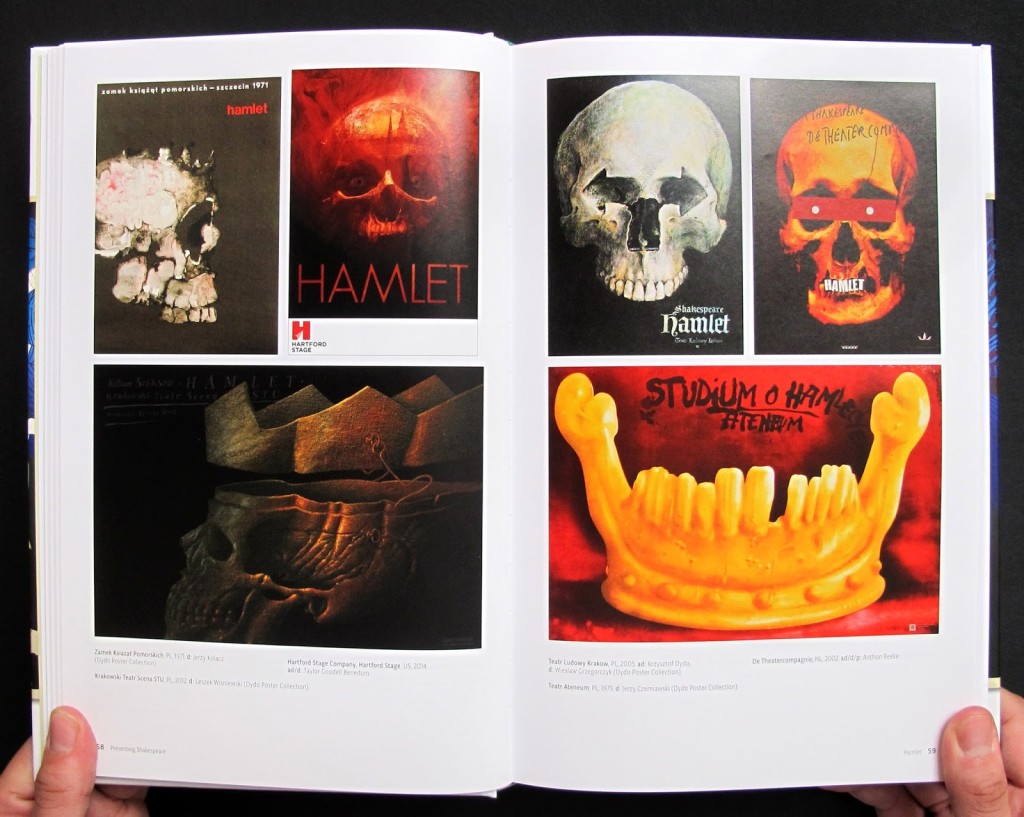
an interior spread
The selection of posters is extraordinary. Some very well known specimens, like Alphonse Mucha’s design for the Sarah Bernhardt Hamlet are included, but the strength of this wonderful book is how far-ranging the choices are. The juxtapositions are visually and intellectually stimulating.
A number of additional photos of book pages can be found on one of the author’s blogs.
The book is available from Amazon here:
Presenting Shakespeare: 1,100 Posters from Around the World
A Trumped-up RICHARD III at Marin Shakespeare
September 19, 2015 § Leave a Comment
Robert Currier’s direction of Richard III at Marin Shakespeare Company is almost completely lacking in subtlety, and his star, Aidan O’Reilly, gives a performance devoid of nuance. I loved it. You see, that is how this production completely captures the current political climate. It is thoroughly relevant and wonderfully insightful about the sad state of partisan discourse in our time!
Politicizing Approaches
Richard III was the earliest of Shakespeare’s Machiavellian anti-heroes, in a strain that would peak with Iago. He is usually played, as in Ian McKellen’s outstanding film rendition, as a cynical fraud, publicly appearing to be the opposite of his evil, scheming true self—which he reveals only in soliloquy. Politically, productions using this approach often seem reminiscent of contemporary right wing pundits warning of the dangers of smooth talking lefties. (Surely I am not the only one who has noticed this rhetoric is usually applied to characterizing Barack Obama, and before him, Bill Clinton as two-faced politicians whose silver-tongued exteriors mask their real beliefs.)
Refreshingly, this is not the approach in this fascinating production, which sits somewhere on the opposite end of the spectrum. O’Reilly’s Richard is anything but smooth. He is loud, brash, and charmless. He says whatever his victims audiences want to hear, but without the slightest pretense (even in the moment) that he actually believes any of it. He preys on the gullibility of those who seem incapable of conceptualizing the existence of self-serving insincerity. Produced during the time period when Donald Trump has suddenly leapt to the top of the leader board in the crowded Republican presidential field, it is not hard to identify a contemporary referent. What might have seemed an unbelievable reading even a year ago, now seems chillingly plausible.
This interpretation says a lot about Richard, but more about his observers who seem to parse his words autistically, without the ability to read the attitudes and emotions that lie behind them. It is a very different production when the focus is not on Richard as imposter, but on everyone else as self-deceiving.
Representing Disability (or Not)
I admit to being thoroughly caught off-guard by the whole approach. All of the pre-publicity for the show focused on the fact that O’Reilly has been legally blind since childhood from retinoblastoma, a rare form of cancer of the light sensing cells of the eyes. Given the enormous amount of focus on questions of representation (that is, who can—and should—represent the characters in the plays) on the stages of Bay Area Shakespeare festivals this summer; along with a great flurry of rehabilitation of Richard’s reputation since his long-lost skeleton was recovered from under a Leicester parking lot in 2012; I was anticipating that O’Reilly might explore (and possibly reinterpret) this most famously disabled Shakespearean character through the metaphor of his own experience. That he did not do. Instead, he characterized Richard’s disfigurements quite conventionally, and as for his own challenges—those were handled so invisibly that one forgot all about them almost immediately. Given the obstacles, including some pretty complex stage combat, it is an amazing performance, but one in which his disabilities were disguised rather than directly referenced.
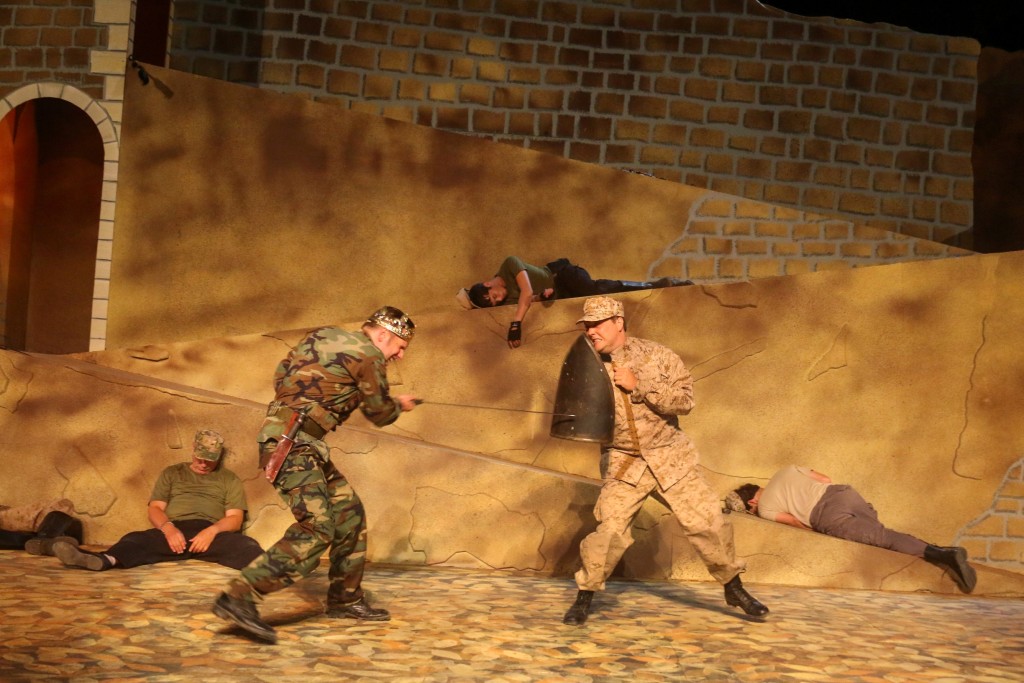
Following a night of ghostly visits by those slain in Richard’s quest for power, Richard III (Aidan O’Reilly) and Lancastrian heir, Richmond (Jackson Currier) meet in battle.
Supporting Cast
The supporting ensemble for this production is the strongest of the season. Michael Ray Wisely is brilliant as Buckingham, the one courtier who sees Richard for what he is and willingly accepts a role as co-conspirator (a la Ted Cruz?), but fails to realize that he is as dispensable as everyone else once he has served his purpose.
Phoebe Moyer as the prophetic, but powerless, former queen Margaret is haunting. The most complex performance of the night is given by Elena Wright, as the mother of the two young rightful heirs to the throne that Richard murders, as she desperately maneuvers to save her surviving daughter. (Those two children, the “princes in the tower,” are played by genuinely outstanding child actors Patrick Ewart and Carl Robinett.)
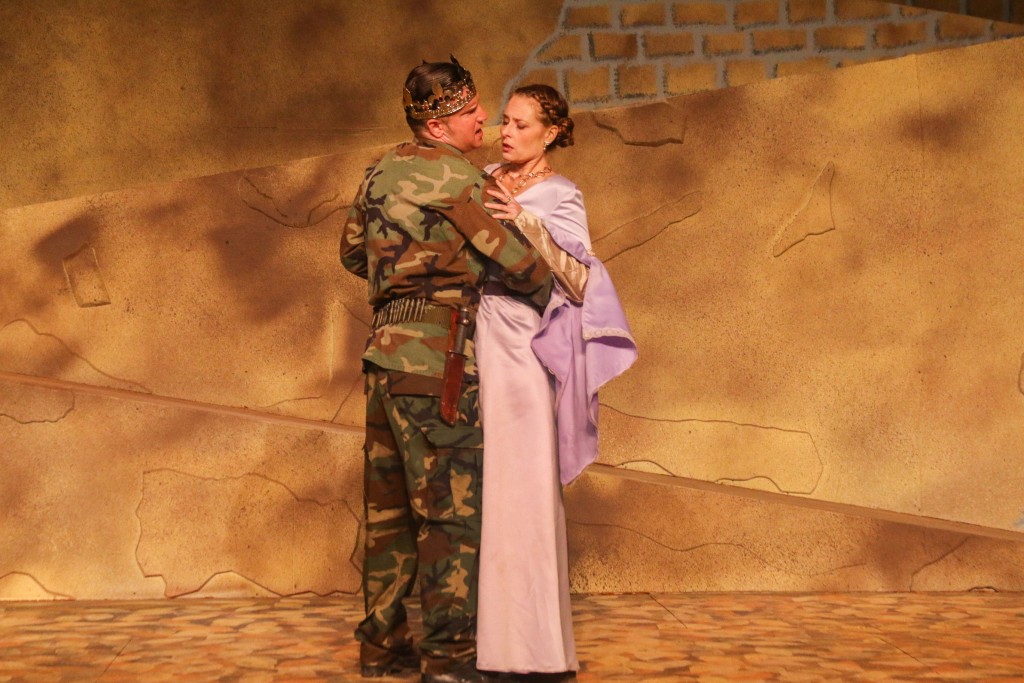
After killing her two sons, Richard III (Aidan O’Reilly) insists that Queen Elizabeth (Elena Wright) arrange for him to marry her daughter.
Several other standouts in the large cast included Michael Schaeffer, Chris Hammond, and Steven Price—all of whom play multiple roles; and Davern Wright, who is chilling as Richard’s henchman Catesby and then proves to be unexpectedly hilarious in the scene where he “spontaneously” exhorts the crowd to support Richard, reading his assigned part off note-cards.
Unfortunately at the performance I saw, Jackson Currier’s voice failed him in the closing sequences when he was playing the hero Richmond (after earlier playing a terrific coke-sniffing, clueless brother to the Queen) so the final moments of the play, which depend on a pair of Henry V-like orations, fell rather flat. Richmond is not the focus of this production, however, so it mattered much less than it ordinarily might.
Camo and Glitter
Abra Berman’s costumes for the production are a mix of period finery layered over contemporary camo fatigues, a perfect metaphor for the way beautiful language is hung on top of pedestrian motives throughout the play.
Jackson Currier’s set, used for multiple plays this summer, is nicely refurbished for this particular play. Joel Eis provides the distinguishing set décor and props.
In the end, it is Richard Currier’s direction that makes this production. Currier is difficult to read, as he usually eschews conceptual approaches, and works hard to stay out of the way of his actors. This production has the strongest viewpoint of any of his I have ever seen, but whether that is intentional or simply a by-product of the zeitgeist is unclear. Whichever, it is certainly provocative!
Everyone’s a Badass: A review of MACBETH at Santa Cruz Shakespeare
August 12, 2015 § Leave a Comment
In Kristen Brandt’s production of Macbeth, Scotland’s aristocratic class of Thanes is composed equally of hulking men straight out of Braveheart and badass, broadsword-wielding warrior women. This is far from the only way that actresses are especially prominent in Santa Cruz Shakespeare’s current offering, but it is the most viscerally startling. Particularly, the magnificent Greta Wohlrabe’s Banquo (absolutely gendered female without having to become Banqua…) is unforgettable from her first bloody appearance.
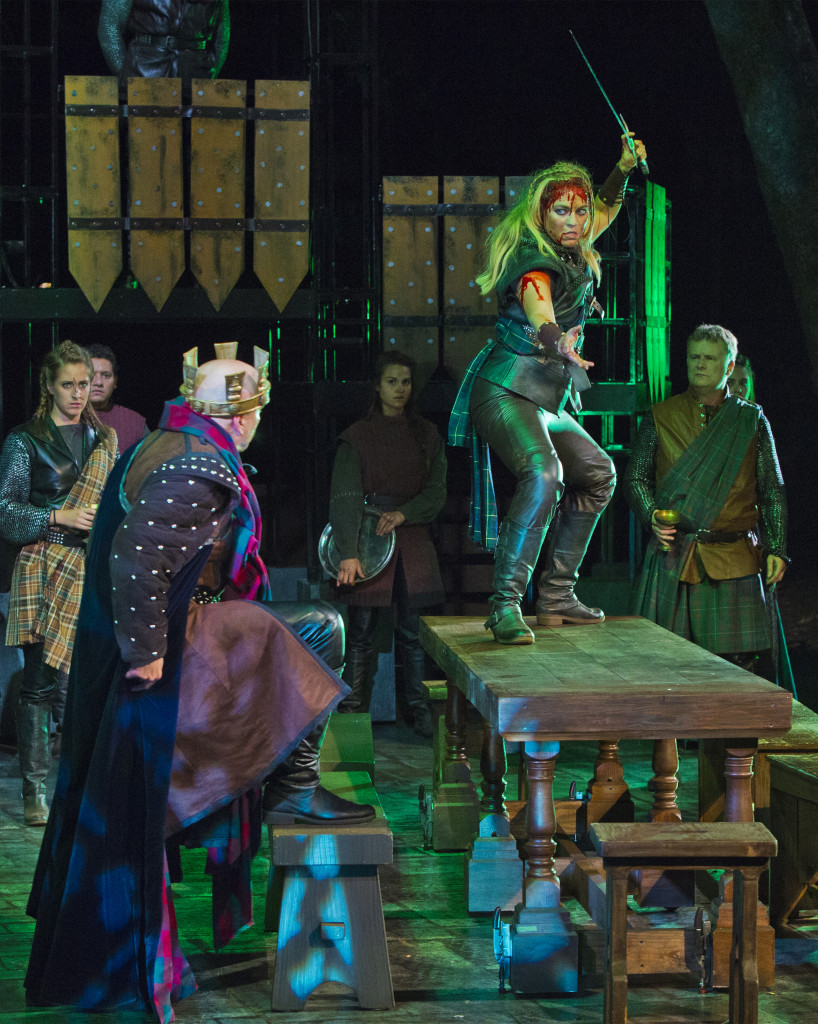
Steve Pickering (Macbeth) and Greta Wohlrabe (Banquo) in Santa Cruz Shakespeare’s Macbeth by William Shakespeare. Also pictured (l. to r.): Madison Kisst, Carlos Angel-Barajas, Kipp Moorman, and Sarah Traisman. Photo by rr jones.
Malcolm, Princess of Cumberland, played by Sierra Jolene; and the Thane of Ross, played by Patty Gallagher, offer more variations on the theme—as do several ensemble players—but even in their less fierce portraits we are closer to Mad Max or an episode of Vikings than the typical Scottish setting.
Sisters and Weird Sisters
Focusing us on women immediately, the play opens with an interpolated scene in which the three “weird sisters” are arrested and accused of collecting body parts from the battlefield for the purposes of witchcraft. This seems to place us in the medieval past, but visually B. Modern’s leather heavy costumes on Nina Ball’s largely metal set combined with the anachronistic female Thanes equally suggested a post-apocalyptic future. Lady Macbeth wears a pre-Raphealite gown that would have made Ellen Terry proud a century ago, but most of the company (women and men) seems perpetually dressed for battle. (I saw an afternoon matinee in the outdoor theatre; Kurt Landisman’s atmospheric lights were effective even though muted.)
The extensive re-gendering of characters (aided by extensive pronoun changes and other textual adjustments) may be more a product of the company’s gender parity policy than the director’s vision, but the immediate effect is a fresh look at the play. Lady Macbeth is tough, but given the world of this production, she does not seem particularly villainous—as an unending stream of misogynistic versions would have her—as much as a product of her times. Her statement that she would kill her own child before backing down on her word (as she accuses Macbeth of considering) seems not monstrous, but simply a matter-of-fact. In director Brandt’s hands, she is also not easily erased. When her death is announced, it is by a character carrying her corpse in a spectacular coup-de-théâtre. The body is immediately handed to Macbeth, and he holds it painfully and awkwardly until he goes forth to fight his final battle.
Oddly, in this world, it is Lady Macduff who seems out of place when she is unwilling or unable to defend herself. Her helplessness does not diminish the tragedy of her murder but it does seem surprising given the number of expert swordswomen we have seen, and have come to accept as unremarkable, throughout the evening.
Feeling as Men
In this particular environment, gender roles are not associated with extremes of masculinity and femininity. Both Steve Pickering as Macbeth, and Toby Onwumere as Macduff, take advantage of this to play more wildly emotional characters than we are used to seeing in these parts. It is a fearless cast, but I would not have predicted that this would manifest in leading men as the ability to play their fears and pain so openly. This was the great revelation of the evening. I did not realize how much, in most Macbeths, the Thane’s masculinity is expressed by emotional detachment and dehumanization until I saw this portrayal which was so vitally alive. Pickering was deeply emotional throughout, especially in soliloquy, and if anything led to his defeat it was that Onwumere (as Macduff) was even more so.
Not everything about the reworking was successful—Malcolm’s equivocating test of Macduff was as interminable as ever, for example—but seeing so much in an altered context kept the production intriguing even when the pace slowed in the second half.
Brandt’s interest was largely in the psychology of character, with the supernatural element substantially less prominent than the Rupert Goold film starring Patrick Stewart or other recent versions. When it came time to kill Banquo, she did select Seyton (Darek Riley) to play the mysterious third murderer, but the insistent pronunciation “SEE-ton,” rather than the punning “Say-tan,” told us that in her vision characters control their own fates rather than being manipulated by evil. In this production, Fleance escaped his assassination because the murderers were inept, not because he was protected.
Brandt is an exciting director. Her production of Merry Wives of Windsor in the same venue a year ago was a revelation because—surprise!—it focused on the wives and not Falstaff. It is not fair to suggest that her production of Macbeth likewise shifts focus to the women. What it does do is re-contextualize both the women and the men so that we can see the story without quite so much sexist baggage. That is a great gift.
Macbeth
August 4–August 30, 2015
Seen August 9
Because It Is the Right Thing To Do: A Review of ROMEO AND JULIET at the San Francisco Shakespeare Festival
August 11, 2015 § 1 Comment
The Artistic Director of the San Francisco Shakespeare Festival, Rebecca J. Ennals, is leading the charge to broaden onstage opportunity in the Bay Area. Her democratizing impulses are prominently on display in her production of Romeo and Juliet, now touring area parks. In addition to featuring actors of color in close to half of the named roles, the production also achieves gender parity by casting actresses in a number of roles that are gendered male. More subtly, the cast also blurs the usually sharp distinction between “character” actors and “leading” actors by utilizing a wide variety of body and voice types in unexpected places.
Improving access onstage is a logical extension of the Festival’s mission of offering free Shakespeare in the park (along the Joe Papp model) to a broad spectrum of community audiences. The performances are enormously popular, playing to large crowds at all four of the Bay Area parks in which performances are held over the course of the summer.
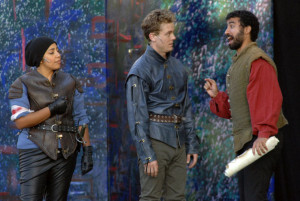
Regina Morones, Carl Holvick and Mohammad Shehata as Benvolio, Romeo and Peter. Photo: Doug Jorgensen
The Concept Is that There Is No Concept
Interestingly, the much-improved diversity is not directly featured as an artistic statement about R&J at all. It is generally treated as invisible in this production. (Or should we say transparent?) That Romeo is a fairly conventionally cast white male who is convincing as a juvenile while Juliet is played by a powerful African-American “leading lady” (rather than an ingénue) is not foregrounded in any way. No West Side Story-style explanations for the feud here.
That Tybalt is played by the obviously female Carla Pantoja, albeit with a false beard to spell out the gender of the character, is just a matter to be taken in stride. She neither makes great effort to hide her underlying gender nor to use it to comment on the mindset of the man she is playing. Regina Morones’ Benvolio is more masculine in execution, but neither her ethnicity nor actual gender is disguised.
If any political point is made by these decisions, it seems to be that in an ideal world they should not matter so very much – and for the most part the production upholds this viewpoint. It is successful as a narrative in which we look through gender, ethnicity, and even the actors’ “types” to see the raw story. Often the surface appearances are contradicting or complicating what we see onstage, but the production offers no consistent viewpoint from that effect. The only convention employed is that we, as audience, are expected to look through the specific representations to a universal theme.
Similar Efforts
It is an interesting and admirable experiment. Similar efforts are going on in many Bay Area Shakespeare festivals this summer. California Shakespeare Festival (known locally as CalShakes) produced an almost all-female Twelfth Night earlier this season in which the actresses quite pointedly (sometimes with hilarious crudity) “commented” on their male personas. The Sacramento Shakespeare Festival produced an original practices (thus all-male) Romeo and Juliet, and then balanced it with an all-female As You Like It. Santa Cruz Shakespeare, meanwhile, is pursuing gender parity in its productions of Much Ado About Nothing and Macbeth, by changing the gender of characters along with all references to their gender in the texts.
In these contrasting examples, the diversity issues are carefully contextualized. Although I prefer this approach, Ennals’ choices are interesting precisely because she offers no internal explanations. The effect is sometimes distracting—I overheard quite a few confused murmurs from nearby audience members—but the crowd eventually accepted that the casting was both color- and gender-blind and stopped trying to read anything more into it.
Uneven Performances
The quality of the performance is uneven, but not because of anything having to do with the diversity choices. The scene painting is amateurish and Ashley Holvick’s costumes, although much better executed, are conventional. Ennals’ staging is frequently messy, and occasionally just odd. (The “morning after” scene, for example, is played on stage level, so the balcony-less Romeo is forced to jump down into the crowd in order to have any sort of descent.) The extensive doubling is successful, although at one point it becomes logistically complicated: Phil Lowery’s Friar Laurence having to be onstage in the final scene means that his Lord Montague cannot be. In the only significant rewriting, therefore, Lady Montague appears onstage in the final scene as peacemaker after the surprising news (to those that know the show well) that her husband has just died.
Romeo and Juliet are compellingly portrayed by Carl Holvick and Lauren Spencer, respectively. Their chemistry and energy are engaging. Spencer’s Juliet is more mature from the outset than any I have seen in years, but she is more effective in the last half of the show than most because she is not childish and she clearly understands the choices she is making. (It is actually kind of refreshing, for once, not to have to focus so hard on overcoming the inherent creepiness of men drooling over a thirteen-year-old.)
Gwen Loeb is wonderfully loud and bawdy as Juliet’s nurse, and in a doubling returns as the usually absent Lady Montague for the final scene, taking over all of her husband’s traditional lines. Phil Lowery’s Friar Laurence is earnest at every turn, and more sympathetic than usual. Mohammed Shehata is a powerful Prince Escalus, and is unrecognizable in his doubling as Peter, which speaks to his versatility. The rest of the cast is serviceable, without anyone standing out in either good or bad ways.
The show features two very surprising—and I think less than successful—choices of convention: in the first, whenever the play features a rhyming couplet with an historic rhyme (that is, one where the words once rhymed but because of pronunciation changes no longer do, such as love/prove or die/remedy) the original pronunciation of one or both is restored to regain the rhyme. That is actually fascinating, but certainly seems odd when numerous other original pronunciation issues—such as preservation of puns or scansion—are ignored.
The second is that after the epilogue, a traditional jig is performed by the full cast as the curtain call. It is not quite historically correct as original practice, as such jigs were separate entertainments (usually with risqué lyrics to songs in addition to the dancing) in Shakespeare’s time and not curtain calls. It was also not quite effective on its own terms since it broke the somber mode without transition or explanation. In these cases, the lack of contextualization (which worked for the casting) was problematic.
As of this writing, the show has finished its run in Pleasanton and Cupertino. It plays Saturdays and Sundays in Redwood City through August 23rd, moves to the Presidio in San Francisco through September 13th, and finishes its run at McLaren Park in SF, on September 27th.
Romeo and Juliet
San Francisco Shakespeare Festival
June 27 – Sept. 27, 2015
Various Locations throughout the Bay Area
Seen August 2, 2015
Never Anything Can Be Amiss: A Review of A MIDSUMMER NIGHT’S DREAM at Portola Valley Theatre Conservatory
August 2, 2015 § Leave a Comment
In their current offering, The Portola Valley Theatre Conservatory creates a conceptually-exciting, immersive staging that engaging explores the contrast between the soul-crushing city and the wild forest at the thematic heart of A Midsummer Night’s Dream.
Portola Valley is a rustic coastal California town, so bucolic that it is hard to believe it is only a half-hour south of bustling San Francisco, and within easy hiking distance of Stanford University. Tucked in between two large land preserves, it is a small dot of civilization placed amidst the giant redwoods. PVTC utilizes this arrangement in its site-specific setting to the fullest.
Site-specific and Immersive
The concept is initiated when one’s reservation is confirmed with a charming (and very contemporary) e-mail in the form of an invitation to Duke Theseus’ upcoming wedding. Along with the ubiquitous engagement photo, it gives the time and place, with a suggestion that the dress code is “layers” and guests might want to bring insect repellent.
Arriving at the site, which turns out to be a local protestant church, one is greeted at the edge of the parking lot by wedding ushers who – completely in character – apologize profusely that things are not quite ready for the ceremony, and in a disturbingly realistic scenario, ask the small audience to cool its heels outside while last-minute arrangements are completed.
When we are finally herded inside, we are led first to a small set representing the office of a wedding planner complete with piles of bridal magazines, catering menus and other commercial paraphernalia that overburdens modern weddings. The contemporary tone is reinforced by Hippolyta (Sarah Benjamin), who wears a t-shirt with a variation on a familiar meme that says, “I can’t keep calm and carry on, I am the bride.” The audience shares the space with the actors, standing around the edges or just sitting down on the floor to watch Egeus intrusively demand that the distracted Duke (Bryce Chaddick) force his daughter, Hermia, (Lydia Cuffman) – against her will – to marry Demetrius (William J. Brown III), instantly identifiable as a hipster because he is wearing his fashionable sunglasses inside.
Take a Hike
After the first scene plays out, we are urged to follow Hermia and her beloved, Lysander (Matt Waters), into the woods where they are fleeing in hiking gear – complete with backpacks and sleeping bags. They are tailed by Demetrius’ ex, Helena (Alanna McNaughton) and by Demetrius, himself. While heading out toward a redwood grove, we encounter the rude mechanicals preparing their play in a courtyard, and pass a strategically placed fairy queen (Cheryl Goodman-Morris) preening over a changeling boy (John Max Byrne).
The second and third acts of the play are staged in the midst of a towering redwood grove, which is directly referenced in the performance in a clever substitution for Shakespeare’s hawthorn brake. (In a similar textual alternation, they will discover in the almanac that not only does the moon shine when they need it, but that it will be the Blue Moon that actually graced the performance.) Although conveniently lit with theatrical instruments and accompanied by Shane Turner’s live score, it is still the dust, stones, sticks and pine scent in the clearing where we gather that make the long night in the woods tactile and immediate. Kevin Gibbs is credited with the “Aesthetic Design.” Even when “off-stage,” fairies hover in the shadows and the sound of the living forest is always present. The scene seems literally enchanting.
My favorite piece of staging happenes on the trip back from the woods, when we observe Bottom’s friends anxiously scouting the horizon for any sign of him – all sitting on the parish hall rooftop. Talk about site-specific! Later we are led back inside to an interpolated, but nicely moving, triple wedding in the chapel, featuring a beautiful tenor solo by Don Gustafson (who also plays Egeus.)
From there we finish our evening on a candlelit patio, drinking champagne and munching petit-fours while (along with the Duke and his party) we enjoy the heartfelt entertainment presented by the rustics. (Ashley Pogue, Andrew Saier, Mark Goodman-Morris, Angela Khalipa, and John Kissel make up this motley crew, along with Andrew P. Quick in the always scene-stealing role of Flute/Thisbe.)
I’m Feeling It
By far the most interesting part of the evening was director Noëlle GM Gibbs’ immersive staging, perfectly fitted to the play. Her conceptual aim sometimes exceeded the grasp of her largely amateur cast, but the aim was, nonetheless, always true. Is there any place that better represents the unromantic excesses of social conformity than a wedding planner’s salon? Conversely, can there be any better way to realize the mystic power of nature than to take us – even a little way – out into the forest? (What was that sound, anyway, and what did I just step on?)
Having seen Midsummer dozens of times, I cannot recall having ever experienced the woods so powerfully. The visceral power of immersive staging, however forced it may initially seem, can transform an ordinary performance into a fully absorbing aesthetic experience as you begin to feel yourself part of the action and the environment becomes a character in the drama.
Unsurprisingly, the Equity guest artist William J. Brown III, as Demetrius, gives the best performance of the evening. (Brown is the Artistic Director of the Arabian Shakespeare Festival, and an actor whose work I have previously admired.) Matt Waters as Lysander and Bryce Chadwick as Theseus also give especially compelling performances.
This production gives unusual prominence to the lovers, and their journey of self-discovery over the course of the night is treated without condescension. They are funny, but more than farcical. The inability to know who we are when overburdened by the demands of civilization, and the liberation of finding our natural selves, emerge as serious themes for once. (Brown’s terrific moment of conversion upon waking from his night in the woods and realizing that he really does love Helena is about as good as acting gets.)
The evening was certainly not without its deficits. The scansion was something of a disaster throughout, and the fairies were garishly costumed Victorian conceptions surprisingly out-of-keeping with natural woods in which they were located. If ever wildly folkloric, instead of tame balletic, fairies were called for, this was the time!
Still, given a play that so thoroughly praises and celebrates the effective sincerity of amateur actors who are giving it their best shot, it would be churlish to deny their winning charm in this case. (I’ve certainly witnessed many fully professional productions that were both less interesting in their ideas and less engaging in their presentation.) Life and art converge in the final scene, where both the characters and their real-life interpreters rise to the occasion when the moment calls for it, and the effect is deeply moving. This is Shakespeare’s love-letter to the theatre, and PVTC’s innovative production makes us see it – no, experience it – freshly and intensively.
A Midsummer Night’s Dream
Portola Valley Theatre Conservatory
July 30 – August 2, 2015
Seen (under the Blue Moon) on July 31
Comedy and Emotion: A Review of THE LIAR at Santa Cruz Shakespeare
July 28, 2015 § Leave a Comment
“Emotion and comedy are enemies,” wrote the great French philosopher Henri Bergson, in a famous essay on humor. Santa Cruz Shakespeare’s beautiful, but strangely heartless, production of The Liar (adapted by David Ives from French neo-classic author Pierre Corneille, who in turn had adapted it from Spanish Golden Age writer Juan Ruiz de Alarcón y Mendoza) is a study in how difficult finding balance can be. There are some terrifically funny scenes in this very pleasant comedy, but the overall effect was oddly cynical about both love and honesty.
Neoclassic Comedy in “Transladaptation”
Since its premiere in 2010 at the Shakespeare Theatre in Washington, D.C., which commissioned this loose translation/adaptation, Ives’ version has become a staple of the Shakespeare Festival circuit. (In the Bay Area, Marin Shakespeare performed it in 2012, in a well-reviewed production I did not see. The following year Livermore Shakespeare Festival performed a version that, as I said in my review, I found charming.) Ives plays with language amusingly in a witty, anachronistic iambic pentameter version that tells the story of a young rake-on-the-make, Dorante, who is perpetually incapable of telling the truth and his hired servant, Cliton, who is equally unable to tell a lie.
Ives is, of course, a well-known playwright of absurdist-flavored comedies of his own devising, especially Venus in Fur – and his screwball rhymes, silly puns, and sly insertion of contemporary observational comedy explain exactly why the Shakespeare Theatre chose him to create this new version of The Liar.
It is Better to Look Good than to Feel Good (Or Is It?)
In Santa Cruz, Nina Ball’s beautiful set, essentially consisting of life-sized black-on-white architectural renderings, and David Mickelson’s elaborate period costumes created a gorgeous spectacle. (I saw an afternoon performance in the outdoor redwood glen SCS uses as its current performance site where Kurt Landisman’s lighting design was not readily discernible, but I have yet to see a design of his that I did not admire.)

Toby Onwumere (Cliton), Brian Smolin (Dorante), and Mary Cavett (Clarice) in David Mickelson’s costumes. All photos by Shmuel Thaler.
Much of the action is farcically mechanical, and when that is the case (like the comings and goings of “a set” of identical twin serving maids with opposite temperaments, played to great effect by Melinda Parrett), Art Manke’s direction is meticulous. Fight choreographer Kit Wilder created a terrific mock duel involving imaginary rapiers that extended that precision from the ridiculous to the hilariously sublime.
More than a Farce
The play is more than a farce, however. Our lying hero, Dorante, is using his talent for prevarication to pursue a young woman who has caught his eye, and in the manner of romantic comedy that leads to an eventual love match. In this case, however, too much comedy becomes the enemy of emotion. It is hard to root for Dorante, or at least Brian Smolin’s chipper but strangely charmless rendition of him because, while his flippant self-absorption got the verbal antics right, it created little empathy. The young woman – or as soon becomes apparent, women – who so entrance him were played by Sierra Jolene and Mary Cavett with wit and verbal dexterity, but as so calculating that it is hard to identify with them, either.
As I observed about Santa Cruz’ other offering in the current repertoire, exploring the callowness of youth does not an evening make. In their outstanding production of Much Ado About Nothing, an engagingly emotional supporting cast provides depth that the youthful leads cannot. There is much less opportunity for such humanity in Ives’ play, but even Kurt Meeker, as Dorante’s long suffering and endlessly forgiving father, stays in key with the rest of the production by playing the part with an emotional distance at odds with the sentiment implicit in the script. The cumulative effect is chilly. When the clever resolution is finally reached, although amusing on a surface level, it is hard to care, and not even clear that it is a good thing.
This peculiar outcome is partially the result of the artificiality of the elevated playing style, partly because of the mask-like quality of the exaggerated make-up, but mostly because the emotional depths of the narrative are left unplumbed. The essential ingredients are all there, but as in a soufflé, it requires delicate handling to makes it rise. The good news is that there is plenty of time left in this run for this gorgeous production to find its emotional balance.
The Liar by David Ives
Playing through August 29, 2015
Seen on July 25
Smart Choices, More Voices: A Review of MUCH ADO ABOUT NOTHING at Santa Cruz Shakespeare
July 26, 2015 § 1 Comment
Mike Ryan is making a lot of smart, invigorating decisions as Artistic Director at Santa Cruz Shakespeare, but the smartest of all might be to feature his own talents as Benedick in their current production of Much Ado About Nothing. He is an exceptional actor, generally under-utilized in dazzling cameos and featured side-kick roles. He is evenly matched by the wonderful Greta Wohlrabe, who was outstanding last season in the secondary roles of Mistress Page in MWW and Celia in AYLI, and is even better now when she is promoted to the central role as Beatrice. Character actors are placed front and center – and celebrated – throughout this production, with the famously quarreling couple masterfully mining the text for both humor and emotional nuance.

Mike Ryan (Benedick) and Greta Wohlrabe (Beatrice) in Santa Cruz Shakespeare’s Much Ado About Nothing. Photo by rr jones.
Rosie the Riveter Revisited
Under the direction of Laura Gordon, the production is set just as the troops return from WWII, with strong Rosie the Riveter-type women tending what appears to be an idyllic California vineyard. (More about those women later!) Nina Ball’s minimalist set and B. Modern’s costumes gave the show a postwar flavor that was never really foregrounded (at least not in the way that a similarly situated Taming of the Shrew at Livermore Shakespeare Festival utilized this tension a couple of seasons ago) but made perfect sense as a background. The gorgeous lighting is by my SFSU colleague Ray Oppenheimer, and Kurt Landisman.
The challenge of Much Ado is that the protagonists – a young Count Claudio and his intended bride, Hero – are not particularly large or compelling parts. Josh Saleh and Sarah Traisman are more than competent in these roles, but exploring the callowness of youth does not an evening make. The energy of the show must come from the supporting characters, particularly from Beatrice and Benedick who have to run the gamut from farce to border-line tragedy. A silly set of clowns also invigorates the proceedings (and provides the actual solution to the plot crisis, albeit accidentally).
Range and Virtuosity
Ryan and Wohlrabe find the complete range of tones in their characters. Both are pleasantly humorous in their farcical scenes but really come into their own when revealing the darker content. They handle the language beautifully, making the text accessible without compromise, but what ultimately makes this a moving and inspiring evening is that they are willing to explore their own emotional vulnerabilities in ways you rarely see in comedy.
Steve Pickering accomplishes a similar virtuosity, although he does it by playing a pair of contracting characters rather than revealing the range of a single one. His sinister Don John, the antagonist of the play, is coldly chilling but by the addition of a pair of glasses and a thick, hick dialect he becomes the hilarious constable Dogberry.
Another source of interest in the evening stems from Ryan’s decision as AD that the organization should try to achieve gender parity in its casting. Because the casts of Shakespeare plays are far from evenly balanced with male and female roles, that involves some careful decisions about how to deal with the mismatch between supply and demand. It is possible for women to simply put on pants and play the male parts (a decision employed by SF Shakes last summer) but Director Laura Gordon settled on prominently regendering the roles of Hero’s father and uncle – Leonato and Antonio become Leonata and Antonia. This is not just a matter of switching pronouns, however. In a play with a plot that so thoroughly incorporates traditional gender roles and male privilege, the resulting shift in perspective could unsettle the balance.
Particularly at the moment of crisis, when Hero’s parent turns on her after Claudio rejects her at the altar as unchaste, only an artist of fierce intelligence and exacting specificity could make that plausible as a mother’s psychological shock rather than a father’s loss of property and “honor.” Fortunately, Patty Gallagher is such an artist. Although known locally for her almost ditzy comic turns, she is both smart and brave, and in this production she totally “goes there.” Backed up with equal strength by Suzanne Sturn as her sister, the about-faces of the characters became not just more plausible, but actually more compelling when they finally do the right thing and confront the callow count and his misogynistic enabler, Prince Pedro. It is worth seeing this production just to watch these two women reinterpret these roles.
Much Ado About Nothing
Playing through August 30, 2015
Seen on July 25
Taymor’s film of MIDSUMMER announces additional showings in NYC, and around the US
July 26, 2015 § Leave a Comment
Three additional New York showings of Julie Taymor’s film of her theatrical production of A Midsummer Night’s Dream have been announced. The first is this Thursday, July 30.
Full information is available here.
I reviewed this film earlier. My review is available here.
Additional showings around the country are available at this location.
A Woman’s World: A Review of AS YOU LIKE IT at the Livermore Shakespeare Festival
July 21, 2015 § Leave a Comment
If this season is the “Year of the Woman” among Bay area Shakespeare Festivals then surely the Livermore Shakespeare Festival, with its female leadership team (Artistic Director Lisa A. Tromovitch, Managing Director Katie Marcel) deserves particular notice. Although they have done nothing to draw particular attention to it, it is worth observing that this summer the festival has an all-female directing staff (Tromovitch and long-time company member Jennifer Le Blanc) and a female-centered repertoire (Sense and Sensibility, As You Like It).
[Note: Managing Director Katie Marcel has pointed out that, although she describes it as a matter of chance and not design, the Board of Directors is also all-female.]
Women Leading
The company is certainly on the move. Tromovitch is the recently elected President of the International Shakespeare Theatre Association and has worked steadily to raise the profile and professionalism of her company over the last five years, including a change for this season to Wente Vinyards as a performance venue.
That new venue provides the key to Tromovitch’s production of As You Like It. Performed on an elevated platform with essentially no scenery and completely surrounded by the audience, the opening night performance had an unforced rapport between the performers and the audience reminiscent of the original conditions for Shakespearean performances. The audience was very close, and never treated as if they were in a separate space. It helped (a lot) that no matter where you sat, audience members were in your direct line of sight across the stage from you. Actors freely passed through the audience for ALL entrances, and those not currently onstage frequently popped into empty seats here and there to watch the show with us.

Michael Wayne Rice as Jacques and the cast of As You Like It.
Costumes by Barbara Murray.
Photo by Gregg Le Blanc, CumulusLight.com.
The resulting casual tone was perfect for just knocking back and enjoying the show, aided by the fact that nearly everyone there was enjoying a glass of wine while they watched. The comfort and ease of the audience interaction was a stark contrast to most Shakespeare, indeed most theatre, that I see where the audience is strongly controlled and subtly intimidated. Here, it was easy to forget that you were watching a four hundred year old play by the-greatest-writer-that-ever-lived. It felt as easy going and enjoyable as a community picnic.
Tromovitch’s take on the show was essentially conservative, with period-ish costumes with a folk flavor designed by Barbara Murray, although she did adopt a very original approach to the dramaturgically troubled ending of the show that surprised and delighted. Her point, however, was not to comment on the show but to fulfill it. Thanks to leading lady Maryssa Wanlass, it was the most emotionally present and engaging AYLI I have seen in some time. Her chemistry with Joseph Salazar (as Orlando) was as fresh and delightful as that of the latest summer rom-com.
A Fiendishly Difficult Favorite
As You Like It is a popular favorite among Shakespeare’s comedies, but is in fact fiendishly difficult to get right. It employs the most music of any Shakespeare play, has a rather unfocused, meandering plot, and typically ends with a literal, and essentially unexplained, deus ex machina in which the god Hymen arrives to set things right – an incident treated so casually that one might assume these characters just interact with gods daily. Things can, and often do, go wrong on all three fronts.
Tromovitch tackles all three of these challenges with a single unifying device – the continual foregrounding of singer Sean Patrick Nill as a kind of metatheatrical narrator. In his hands, often accompanied by other cast members vocally and on instruments, the music is aesthetically engaging while used to tie the story together. When he subsumed the role of Hymen at the play’s end – because he had seemingly been manipulating the story from slightly outside and above the play all evening – it, for once, made sense!
Layers of Plot
The plot is complicated: a dispossessed young man, Orlando, falls in love with the beautiful niece of his corrupt Duke, but is so green and awkward he falls back on clichéd love poems to woo her. The niece, Rosalind, is herself forced to flee from her uncle, who usurped the crown from her father. To protect herself, she goes into exile disguised as a man. They meet again in the woods where both have fled. Orlando does not recognize her through her male disguise, but agrees to some tutoring from her (in her male persona) during which s/he will imitate his beloved for him in a role-playing exercise. At the center of the play is a scene in which (in the original, a boy-actor playing) a woman who is disguised as a man pretends to be a woman (in fact, herself) in order to teach her leading man how to be more genuine and assertive. It is a feat of real skill to keep all these levels clear – especially when the characters get them confused. Tromovitch handled this scene as cleverly as I have ever seen it, with Salazar’s befuddled Orlando becoming increasingly confused about who, exactly, he is falling in love with – the girl or the boy.
Things work out predictably for the couple, and for several other couples that provide variations on the theme in a series of related subplots, but not until the inevitable ending has been delayed as long as possible by the loose diversions found in a summer paradise.
It takes a lot of work to make this all happen but Tromovitch achieves it all with such a light touch that her direction is essentially invisible. Looking back, the engaging evening flew past but felt as indulgent as a chocolate truffle. Strong performances from Patrick Andrew Jones as Orlando’s reforming older brother, William J. Wolak as his faithful servant, and Lindsey Marie Schmeltzer as an overly proud local yokel who falls in love with Rosalind’s male alter ego proved high points.
The cast was not universally strong, which showed particularly in some unconvincing doublings that were neither executed with versatility on their own terms nor justified in their undisguised reuse of actors by a performance convention. Also, as is often the case, some of the more dated farcical parts of the play that have lost their point over time became strained searching for a laugh.
The performance had far more strengths than weaknesses, however. It was a perfect match of venue and play – a light midsummer comedy in an intimate, casual park-like setting. Only the hardest of hearts could possibly resist the swift and glorious ending.
A Company to Watch
Perhaps it is assuming too much to think that the marvelous sympathy between directorial approach and the leading actress’ strengths has anything to do with their shared gender. Maybe it is just Tromovitch’s directorial skills, and not her particular insights into this woman-focused play, that get the tone of this intricate comedy so right. Conceivably, the particularly invitational, friendly environment established in the new venue is the product of good audience engagement research and has nothing to do with the sensibilities of an all-female management team. It is worth contemplating, however, whether more than coincidence is at work. Let’s keep our eye on Livermore Shakespeare Festival to see if women’s leadership continues to provide unique results!
As You Like It
Livermore Shakespeare Festival
Through August 2, 2015
Wente Vinyards, Livermore CA
Seen: July 17, 2015
Dreaming of a Better World: A Review of LIFE IS A DREAM at CalShakes
July 12, 2015 § Leave a Comment
Attending the live theatre can be fun, intriguing, informative, provocative, entertaining, educational… but what keeps me coming back show after show is that every once in a while everything aligns and a night in the theatre is just magical. Such is the case with CalShakes’ beautiful, lyrical production of Calderón de la Barca’s Life is a Dream directed by the brilliant Loretta Greco.
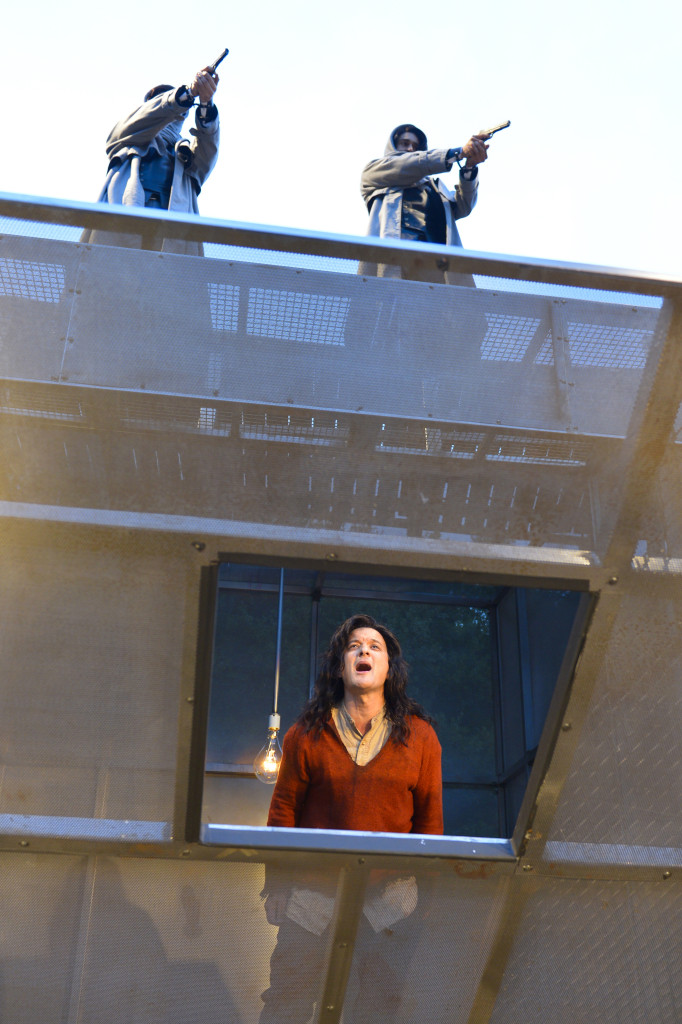
(Above) Carlos Berrera and Kaiso Hill; (below) Sean San José as Prince Segismundo in California Shakespeare Theater’s Life Is a Dream, directed by Loretta Greco; all photos by Kevin Berne.
Anything but Dry
Finding the heart of this Siglo de Oro (Spanish Golden Age) masterpiece is not easy. Usually called a “philosophical drama,” it is, on the rare occasions when is performed, often cold and mechanical. The opposite was the case here. Pulitzer-prize winner Nilo Cruz’ (Anna in the Tropics) translation and adaptation was a key to capturing the shimmering other worldliness – that quality that was later to be called “magic realism” – that permeates the original, but seems so elusive in English.
(That the drama of the Spanish renaissance is so shamefully neglected on the stages of Shakespeare festivals – despite the fact that here on the West Coast a plurality of the population is of Hispanic heritage – especially when French farce is such a staple, is a rant for another day. For now, let me just honor Artistic Director Jonathan Moscone’s opening night statement that it is exceptionally difficult to find the right artist to “unlock” these plays. Greco is absolutely the right artist!)
A Son Betrayed
La vida es sueño tells the story of a crown prince, Segismundo, imprisoned and isolated from birth because ill-omens suggested he would become a oppressive tyrant and overthrow his father, who is drugged and brought to court for one day as a test before one of his cousins is named heir in his place. It is a test that he fails miserably, having known nothing but a brutish, caged existence. The tiny bit of education and philosophy given him by his sole caretaker, a nobleman named Clotaldo, cannot steer him through his first encounters with luxury, power, and especially with the lust he feels when he encounters women for the first time. After a disastrous day, he is again drugged and returned to his cell, where he is led to believe that it was all nothing but a dream. Clotaldo suggests that what he can learn from his “dream” is that it is important to strive for goodness and mercy at all times, even where it seems one has no control.
Segismundo’s existence having become known, however, sets off a civil war and he is freed by his people who refuse to accept the rule of the foreign-born cousins. Now unable to distinguish what is real and what is imaginary so reliant only on pure principle, Segismundo successfully leads the rebellion and conquers the father that has so painfully betrayed and abandoned him, leading to a stunning final encounter.
Otherworldly Beauty
Cruz’ translation and Greco’s production set this story indefinitely in both time and space. Andrew Boyce’s graceful set is a single platform that spirals into the sky above a plain metal box that serves as a cell. Guns and steel suggest the time is not “then,” while capes and swords suggest that it is also not “now.” No geographical references occur at all. Alex Jaeger’s vaguely period costumes and the crystalline illumination by Tony-award winning light designer Christopher Akerlind create a world that is both accessible and ephemeral.
Greco does not make any contemporary references explicit, but the inescapable parallels to repressive regimes, betrayed generations and the seeming unreality of much of modern life float forward anyway. A light touch has a huge impact.
Stunning Cast
Segismundo is usually played by a Hamlet-like tragic hunk, but the revelation of the night was the extraordinary central performance by the man-child Sean San Jose. His simple awe at everything he encountered coupled with his quick, deep connection to his emotions made his transcendent performance moving beyond description.
The moral center of the play is Clotaldo, caught between loyalty to his king and his duty as caretaker to Segismundo. Julian López-Morillas, an artist with long and deep ties to this community, brought to the role the same intensity and humanity that illuminated his revelatory performance as Geronimo in Marin Shakespeare’s The Spanish Tragedy two seasons ago.
Performances of the play usually fall apart around the tangential sub-plot about a young woman seduced and spurned by Segismundo’s cousin, Astolfo. Never having known her father, and unable to find any champion, she sets off in male disguise and with a comic side-kick to seek revenge, where she encounters Segismundo in his prison and eventually finds her real father and her destiny. Even bravura performances often fail to make the role rise above the improbability and coincidence.
In the hands of Sarah Nina Haydon, however, this Rosaura becomes something else. She finds her own suffering parallel to Segismundo’s, not least because of the way that it keeps intensifying through circumstances that she experiences as surreal. Her life is as nightmarishly dreamlike as is the protagonist’s, and as revealed by the delicate handling of her performance under Greco’s direction, as ours.
The cast is uniformly superb. Amir Abdullah is charismatic as the complex cousin Astolfo. Company favorite Tristan Cunningham has never been better utilized than she is as the radiant competing cousin Estrella. Adrian Roberts is a commanding presence as the conflicted king. Jomar Tagatac is by turns hilarious and then devastating as Rosaura’s pragmatic side-kick. Even the unnamed parts were fulfilled brilliantly by Carlos Barrera, Kaiso Hill and, especially, a compelling Jason Kapoor – whose reappearance in multiple roles rose above utilitarian and became yet another element that made the production feel dreamlike.
Another Dream Play
When the play finally reaches its climax, with the conquering Segismundo facing down his self-serving father, honest but inadequate tutor, love-interest who is in love with somebody else, and scheming cousins, the adaptation by Nilo Cruz takes an unexpected turn away from the predictably mundane resolution of the plot and leaps into the poetic heights reminiscent of Shakespeare’s dream play, Midsummer. It is a gasp-inducing conclusion that feels perfectly suited to the cultural moment. Theatre does not get better than this.
Life is a Dream
Playing through August 8, 2015
California Shakespeare Theatre
July 11, 2015
